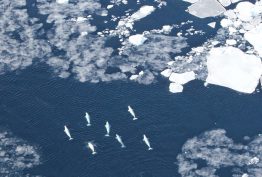Research led by the UW’s Department of Atmospheric Sciences proposes a new idea that may explain why some Antarctic icebergs are tinged emerald green rather than the normal blue, potentially solving a decades-long scientific mystery. Most icebergs appear white or blue when floating in seawater, but since the early 1900s, explorers and sailors have reported seeing peculiar green icebergs around certain parts of Antarctica.
Read more at UW News »Study identifies which marine mammals are most at risk from increased Arctic ship traffic
In recent decades, parts of the Arctic seas have become increasingly ice-free in late summer and early fall. As sea ice is expected to continue to recede due to climate change, seasonal ship traffic from tourism and freight is projected to rise. A study from the University of Washington and the University of Alaska Fairbanks is the first to consider potential impacts on the marine mammals that use this region in autumn and identify which species will be most vulnerable.
Read more at UW Today »Three UW Innovation Awards given to UW Environment faculty
College of the Environment faculty received all three of the University of Washington’s Innovation Awards for 2018. The awards are designed to stimulate innovation among faculty from a range of disciplines and to reward some of their most novel ideas, and are made possible by generous donors. Knut Christianson and Michelle Koutnik from the Earth and Space Sciences, along with David Shean from Civil and Environmental Engineering, were awarded $300,000 over two years to “build a digital glacier time machine” that will generate a high-resolution, 3-D time series of how glaciers have changed over time to help understand the future of water resources in the western United States.
Read more at the Office of Research »Salt pond in Antarctica, among the saltiest waters on Earth, is fed from beneath
At the base of the Transantarctic Mountains lies a geological oddity. Don Juan Pond is one of the saltiest bodies of water on the planet, filled with a dense, syrupy brine rich in calcium chloride that can remain liquid to minus 50 degrees Celsius, far below the freezing point of water. But the source of water and salt to this unusual pond remains a mystery — even as hints emerge that water in a similar form could exist on Mars.
Read more »UW's Kristin Laidre awarded Pew marine fellowship to study effects of climate change, subsistence hunting on polar bears
Polar bears depend on sea ice for essential tasks like hunting and breeding. As Arctic sea ice disappears due to climate change, bears across the species’ 19 subpopulations are feeling the strain. But even as scientists try to quantify just how much melting sea ice is affecting polar bears, another group that depends on the iconic mammal for subsistence also is at risk of losing an important nutritional and economic resource.
Read more at UW Today »





